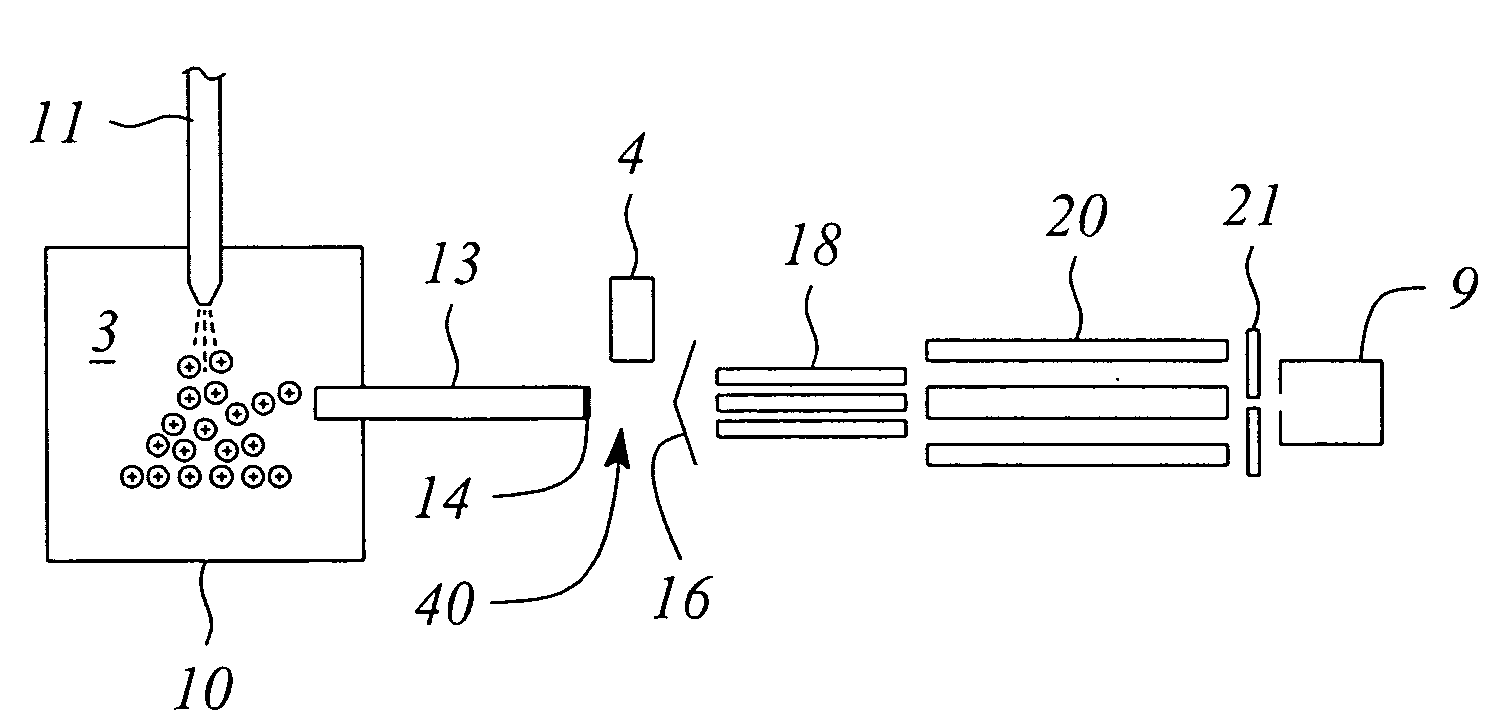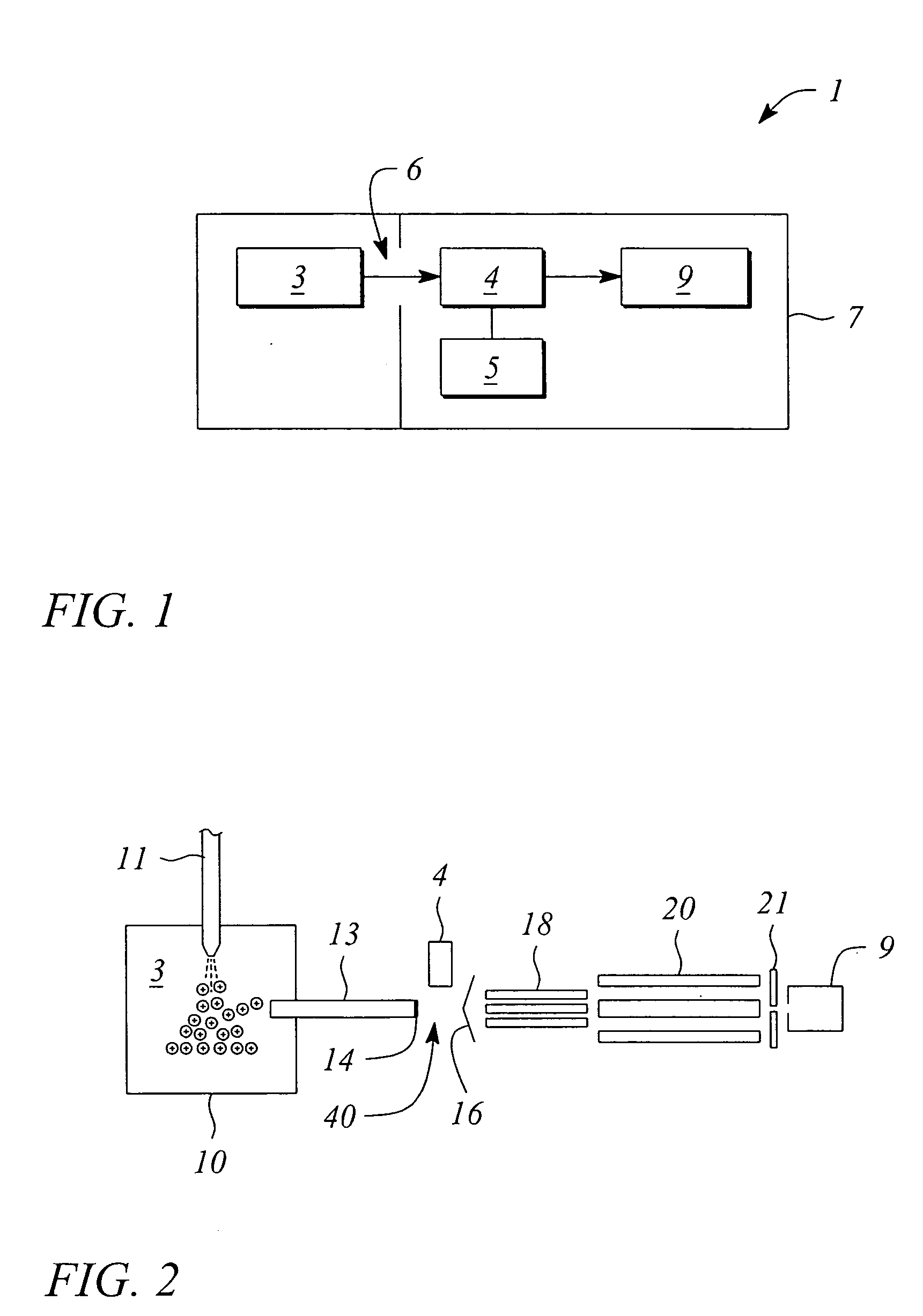Photoactivated collision induced dissociation (PACID) (apparatus and method)
a technology of photoactivated collision and dissociation, which is applied in the field of photoactivated collision induced dissociation (pacid) (apparatus and method), can solve the problems of inability to accurately and accurately measure the mass of the sample, and inability to achieve the effect of mass spectrometry
- Summary
- Abstract
- Description
- Claims
- Application Information
AI Technical Summary
Benefits of technology
Problems solved by technology
Method used
Image
Examples
first embodiment
[0036]FIG. 2 shows the present invention in single MS mode. The figure shows an ion source 3 enclosed in an optional housing 10. An optional nebulizer tip 11 is also shown releasing ions into a capillary 13. In this embodiment of the invention electrical element 5 comprises one or more electrodes (as will be discussed later). For instance, a first electrode 14 is positioned adjacent to the exit end of the capillary 13. It should be noted that the electrical element 5 may comprise a separate or integrated structure with capillary 13 (note that electrical element 5 is not labeled in FIG. 2 since it comprises first electrode 14. Please refer to FIG. 1 for clarification).
[0037]A skimmer 16 is positioned downstream from the first electrode 14. An optional ion guide 18 may also be employed before the mass spectrometer 20. Ion guide 18 is employed for moving and directing ions into the mass spectrometer 20. The mass spectrometer 20 may comprise a mass filter or ion guide. In the present em...
second embodiment
[0038]FIG. 3 shows the present invention in MS / MS mode. This embodiment of the invention is similar to FIG. 2. However, in this embodiment of the invention the first electrode 14 is dispose adjacent to the photon source 4 and interposed between a first mass spectrometer 20 and second mass spectrometer 24. A collision cell 23 is disposed adjacent to the photon source 4. The collision cell 23 is employed for fragmenting and / or confining / transporting molecules before they enter the second mass spectrometer 24.
[0039]FIG. 4 shows a similar embodiment of the invention to FIG. 3, but the photon source 4 is disposed in or in contact with the collision cell 23.
[0040]FIG. 5 shows a similar embodiment of the invention to FIG. 4, but an ion trap 36 is employed with the present invention. In addition, the photon source 4 is disposed in the ion trap 36. It should be noted that the photon source 4 need not be disposed in the ion trap 36. For instance, in other embodiments of the invention it is an...
sixth embodiment
[0042]FIG. 7 shows the present invention. This embodiment of the invention is similar to FIG. 6, but the photon source 4 is disposed in the collision cell 23. In the GC MS and GC MS / MS embodiments the entire system can be enclosed in a single housing (not shown). For instance, the ion source 3, the photon source 4, the ion optics 6 and the detector 9 may all be in the same housing 7. The housing 7 may be maintained under vacuum (see FIG. 1 for further clarification on the housing).
[0043]In contrast, in the embodiment of the invention that are used for LC MS or LC MS / MS the ion source 3 may be separated from the other components. The ion source 3 may be maintained at atmospheric pressure while the remainder of the instrument and / or components may be maintained under vacuum.
[0044]FIGS. 3-4 and 6-7 show embodiments of the present invention where a collision cell 23 and collision gas are employed with the present invention to promote fragmentation of the sample. In most cases, the colli...
PUM
 Login to View More
Login to View More Abstract
Description
Claims
Application Information
 Login to View More
Login to View More - R&D
- Intellectual Property
- Life Sciences
- Materials
- Tech Scout
- Unparalleled Data Quality
- Higher Quality Content
- 60% Fewer Hallucinations
Browse by: Latest US Patents, China's latest patents, Technical Efficacy Thesaurus, Application Domain, Technology Topic, Popular Technical Reports.
© 2025 PatSnap. All rights reserved.Legal|Privacy policy|Modern Slavery Act Transparency Statement|Sitemap|About US| Contact US: help@patsnap.com



